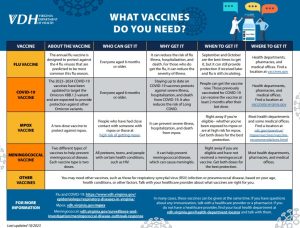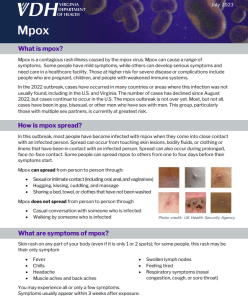If You're at Risk, Get Vaccinated!
People who are at risk of exposure to mpox or have been exposed to mpox are eligible for the two-dose mpox vaccine. If you think you’re eligible, get vaccinated right away.
If you got your first dose and still need your second, it's not too late to get it!
About the vaccine
JYNNEOS is the two-dose vaccine used for the prevention of mpox. The second dose is given 28 days after the first dose. It is important to get both doses of vaccine for the best protection.
Vaccination is not a treatment for mpox. If you think you're sick with mpox, contact a healthcare provider to discuss testing and treatment options.
Who should get the vaccine
People who are at risk of exposure to mpox or have been exposed to mpox are eligible for the mpox vaccine.
If you’ve been exposed to mpox it’s best to get vaccinated within 14 days of your last exposure, ideally with four days.
The vaccine will prevent you from getting mpox or make your illness less severe if you do get mpox. Visit CDC’s website to learn more about who should get the mpox vaccine.
Even if it has been longer than 28 days since you received the first dose, it is not too late to get the second dose. You don't have to restart the vaccination series.
Where to get the vaccine
Vaccines are available at participating local health departments, pharmacies, and other healthcare providers.
Before booking an appointment, call to make sure they carry the mpox vaccine.
Medicaid, Medicare, and most private insurance plans will cover the cost of the vaccine. People with private insurance should call their plan to see what type of coverage they have. For those who have no insurance coverage, contact your local health department about low cost or free mpox vaccination.
Getting the vaccine
You can get the vaccine in two different ways:
- Subcutaneous vaccination- means you will get the vaccine in the fatty tissue of your upper arm.
- You might consider asking for a subcutaneous vaccination if:
- You get keloid scars (thick, raised scars) or
- You are younger than 18 years of age
- You might consider asking for a subcutaneous vaccination if:
- Intradermal vaccination- means you will get the vaccine between the layers of the skin in your forearm. If you don’t want the vaccine given in your forearm, you can ask to get it in the skin of your upper back or shoulder instead.
People aged 18 years and older can talk with their provider about which type of vaccine (intradermal or subcutaneous) they prefer to get.
It is helpful to wear loose-fitting clothing and to make sure that the vaccine site is easy to access. Your provider might ask you to wait 15 minutes to observe you for reactions.
For more information about what to expect when receiving the JYNNEOS vaccine, visit the CDC’s website.
You may be able to also receive your COVID-19 or flu shot at the same visit. Ask your healthcare provider which vaccines are available and recommended for you. In some cases, a person might wait four weeks between getting the COVID-19 and JYNNEOS vaccines.
After vaccination
The vaccine begins to protect you 14 days after your second dose (about six weeks after your first dose). You should continue to take precautions against mpox between doses.
It is possible to get sick with mpox after vaccination. But after vaccination, you are less likely to be severely sick or be hospitalized. CDC offers more information about mpox infections after vaccination.
For a record of your mpox vaccination, visit the mpox record request portal.
After vaccination, continue to take other steps to protect yourself from mpox. It's still possible to get sick with mpox after vaccination, but you are less likely to be severely sick or be hospitalized.
Opens pdf to download
Opens document to download
Opens in a new window
External link will open in a new window. Click link to exit Virginia Department of Health Website.




